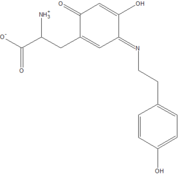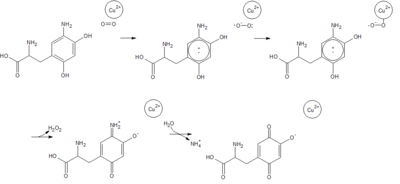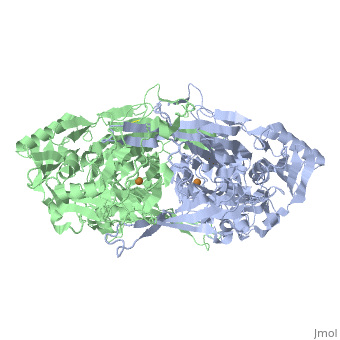Structure

Residue 382 is a tyrosine residue, modified into topa-quinone, shown here bound to tyramine.
Copper amine oxidases or primary amine oxidase (CuAO) are classified as EC 1.4.3.6 in the EC number classification system of enzymes, and they belong to the larger class of oxidoreductases. 2d1w is the tyramine-bound substrate Schiff-base intermediate of copper amine oxidase derived from Arthrobacter globiformis. The structure of this enzyme was determined by Murakawa et al. in 2005, by x-ray diffraction[1]. It consists of a disulfide-linked homodimer, with each subunit containing 638 residues. Each subunit also contains a near the active site, which is coordinated by three histidine residues. Located near the Cu2+ ligand is a tyrosine residue that has been modified into topa-quinone (TPQ), which is also a cofactor in all other copper amine oxidases[2]. The active site of the enzyme is located near the center of the homodimer, which is connected to the outside of the enzyme by an extensively hydrated channel. It is suspected that the water helps to carry O2 to the active site, as well as being used in the reaction itself[3]. . Water molecules are shown as red spheres.
CuAO from Arthrobacter globiformis is called phenylethylamine oxidase undergoes reduction of phenylethylamine and forms phenylacetaldehyde.
Reaction Mechanism
Copper amine oxidase catalyzes the oxidation of a primary amine to the corresponding aldehyde, yielding hydrogen peroxide and free ammonia. An example of this is the oxidation of tyramine:

The oxidation of tyramine, yielding the corresponding aldehyde, hydrogen peroxide, and ammonia.
Reductive half-reaction
In the reductive half-reaction, the carbonyl of topa-quinone reacts with the primary amine of the substrate, forming the substrate Schiff-base intermediate (2cwv). The α-proton is then abstracted by a conserved aspartic acid residue (Asp298), which forms the product Schiff-base intermediate (2cwv). Several studies have shown that the abstraction of the α-proton proceeds through quantum-mechanical tunneling, which allows the proton to pass through an energy barrier which it would otherwise not be able to pass according to classical mechanics[1][4].This bond is then hydrolyzed, which yields the aldehyde form of the substrate, the aminoquinol form of topa-quinone, and a proton.

The reductive half-reaction in the oxidation of a primary amine by copper amine oxidase.
Oxidative half-reaction
In the oxidative half-reaction, electrons are transferred from the reduced form of topa-quinone to O2, forming a superoxide ion that is stabilized by the Cu2+ ligand. Reduction of the superoxide by the amino-quinone form of topa-quinone yields peroxide and the imino-quinone form, leading to the release of hydrogen peroxide. Hydrolysis of the imino-quinone form of topa-quinone then releases free ammonia, and regenerates the oxidized form of topa-quinone[4].

The oxidative half-reaction, in which topa-quinone is restored to its oxidized form, releasing ammonia and hydrogen peroxide.
3D structures of copper amine oxidase
Copper amine oxidase 3D structures





